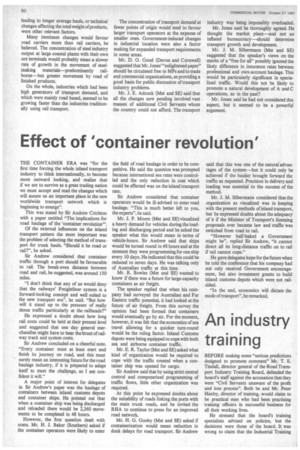Rail share likely to decline
Page 51

Page 52

If you've noticed an error in this article please click here to report it so we can fix it.
FOUR MAIN POINTS were stressed by Mr. Colin Jones, transport correspondent of Financial Times in his wide-ranging paper "The future of inland transport in relation to trade and industry".
First, it could be dangerous to talk of freight transport as if it were one huge, homogeneous activity. It was, rather, a heterogeneous agglomeration of many small, specialized markets requiring specialized vehicles and handling facilities. Traffic moved on different routes of varying lengths, frequencies, regularities and volumes.
Second, freight movement distances in this compact island were generally short— on average only about 40 miles, or 45 miles if local distribution work was excluded. Average hauls for private own-account transport were about 24 miles, excluding local distribution. The average professional operator's haul was about 34 miles and the average rail haul was 70 miles—or 135 miles for merchandise-only traffic. By general reckoning any haul exceeding 100 miles counted as long distance, and not more than one eighth of total freight tonnage moved a long distance.
The third characteristic involved cost factors. All told, nearly £3,000m a year was spent on goods movement—about 8 per cent of total expenditure on all goods and services. At the national level the objective should be to ensure that traffics flowed by the means of transport that imposed the least real cost in terms of national resources. At the level of the individual consignor the objective was to see that goods moved at the cheapest cost commensurate with the service required.
Mr. Jones' fourth point referred to private own-account transport. About one-third of all road freight traffic, and at least one eighth of total inland freight, was carried by these fleets, he said. The future natural role of the railways in freight carrying in this country might be smaller than today, suggested Mr. Jones.
The present threshold between road and rail costs making road cheaper at some point between 100 and 150 miles would probably be raised, he thought, by the completion of the motorway programme in the early 1970s. The linking of M6 and MI would be particularly significant. Even if the railways—at vast expense—raised freight train speeds from 75 mph to 150 mph it would only mean a saving of 40 minutes on a distance of 100 miles.
The speaker said that the demand for freight transport recently had risen faster than the level of total national production, indicating a greater transport input per unit of product. This was possibly due to divergent trends of output—between goods generating a high transport demand and those requiring less transport. Locational changes in industry leading to longer average hauls, or technical changes affecting the total weight of products, were other relevant factors.
Many imminent changes would favour road carriers more than rail carriers, he believed. The concentration of steel industry output at large coastal plants with their own ore terminals would probably mean a slower rate of growth in the movement of steelmaking materials—predominantly railborne—but greater movement by road of finished products.
On the whole, industries which had been high generators of transport demand, and which were mainly road based, seemed to be growing faster than the industries traditionally using rail transport. The concentration of transport demand at fewer points of origin would tend to favour larger transport operators at the expense of smaller ones. Government-induced changes in industrial location were also a factor making for expanded transport requirements in some areas.
Mr. D. 0. Good (Devon and Cornwall) suggested that Mr. Jones' "enlightened paper" should be circulated free to MPs and to trade and commercial organizations, as providing a good basis for public discussion of transport industry problems.
Mr. J. E. Adcock (Met and SE) said that all the changes now pending involved vast masses of additional Civil Servants whom the country could not afford. The transport industry was being impossibly overloaded.
Mr. Jones said he thoroughly agreed. He thought the market place—and not an inflated bureaucracy—should determine transport growth and development.
Mr. J. M. Silbermann (Met and SE) suggested that the speaker's views on the merits of a "free for all" possibly ignored the likely difference in insurance rates between professional and own-account haulage. This would be particularly significant in specialized traffic. Would this not be likely to promote a natural development of A and C operations, as in the past?
Mr. Jones said he had not considered this aspect, but it seemed to be a powerful argument.






















































































































